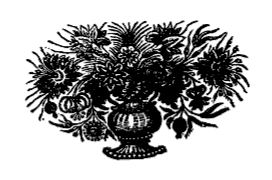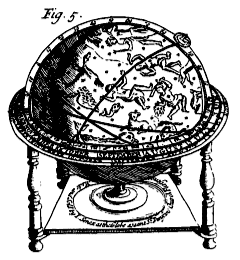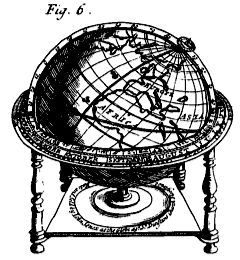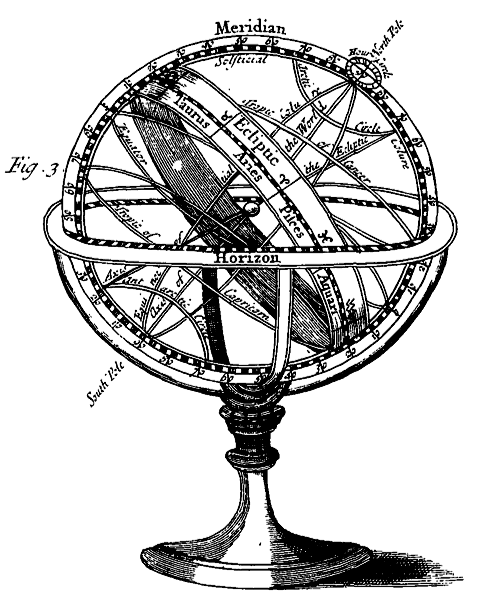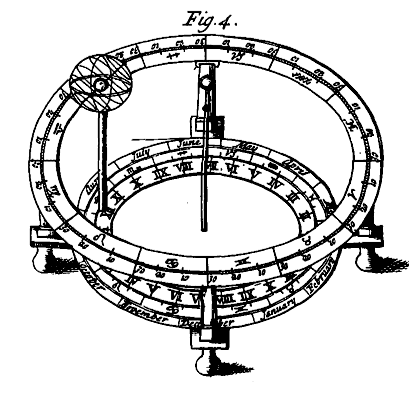A lesser Circle is that which is parallel to a greater, as the Tropicks and Polar Circles are to the Equator, and as the Circles of Altitude are to the Horizon.
The great Circles are,
I. The Horizon, which is a broad wooden Circle encompassing the Globe about, having two Notches, one in the North, the other in the South part thereof, for the Brazen Meridian to stand, or move round in, when the Globe is to be set to a particular Latitude.
There are usually reckoned two Horizons: First, The Visible or Sensible Horizon, which may be conceived to be made by some great Plane, or the Surface of the Sea; and which divides the Heavens into two Hemispheres, the one above, the other (apparently) below the Level of the Earth.
This Circle determinates the Rising and Setting of the Sun, Moon, or Stars, in any particular Latitude: for when an one of them comes just to the Eastern edge of the Horizon, then we say it Rises; and when it doth so at the Western edge, we say it Sets. And from hence also is the Altitude of the Sun or Stars reckoned, which is their height in Degrees above the Horizon.
Secondly, The other Horizon is called the Real or Rational Horizon, and is a Circle encompassing the Earth exactly in the middle, and whose Poles are the Zenith and Nadir, that is, two Points in its Axis, each 90 deg. distant from its Plane, (as the Poles of all Circles are) the one exactly over our Heads, and the other directly under our Feet. This is the Circle that the wooden Horizon on the Globe represents.
On which Broad Horizon several Circles are drawn, the innermost of which is the Number of Degrees of the Twelve Signs of the Zodiack, viz. 30 to each Sign: for the ancient Astronomers observed the Sun in his (apparent) Annual Course, always to describe one and the same Line in the Heavens, and never to deviate from this Tract or Path to the North or South, as all the other Planets did, more or less: and because they found the Sun to shift as it were backwards, thro all the Parts of this Circle, so that in one whole Year's Course he would Rise, Culminate, and Set, with every Point of it; they distinguished the fixed Stars that appeared, in or near this Circle, into 12 Constellations or Divisions, which they called Signs, and denoted them with certain Characters; and because they are most of them usually drawn in the form of Animals, they called this Circle by the Name of Zodiack, which signifies an Animal, and the very middle Line of it the Ecliptick; and since every Circle is divided into 360 Degrees, a twelfth part of this Number will be 30, the Degrees in each Sign.
Next to this you have the Names of those Signs; next to this the Days of the Months, according to the Julian Account, or Old Stile, with the Calendar; and then another Calender, according to the Foreign Account or New Stile.
And without these, is a Circle divided into thirty two equal Parts, which make the 32 Winds or Points of the Mariners Compass, with the Names annexed.
The Uses of this Circle in the Globe are,
1. To determine the Rising and Setting of the Sun, Moon, or Stars, and to shew the time of it, by help of the Hour Circle and Index; as shall be shewn hereafter.
2. To limit the Increase and Decrease of the Day and Night: for when the Sun rises due East, and sets West, the Days are equal.
But when he Rises and Sets to the North of the East and West, the Days are longer than the Nights; and contrariwise, the Nights are longer than the Days, when the Sun Rises and Sets to the Southwards of the East and West Points of the Horizon.
3. To show the Sun's Amplitude, or the Amplitude of a Star; and also on what Point of the Compass, it Rises and Sets.
II. The next Circle, is the Meridian, which is represented by the brazen Frame or Circle, in which the Globe hangs and turns. This is divided into four Nineties or 360 Degrees, beginning at the Equinoctial.
This Circle is called the Meridian, because when the Sun comes to the South part of it, it is Meridies, Mid-day, or High-noon; and then the Sun hath its greatest Altitude for that Day, which therefore is called the Meridian Altitude. The Plane of this Circle is perpendicular to the Horizon, and passeth thro the South and North Parts thereof, thro the Zenith and Nadir, and thro the Poles of the World. In it each way from the Equinoctial on the Celestial Globe, is accounted the North or South Declination of the Sun or Stars; and on the Terrestrial, the Latitude of a Place North or South, which is equal to the elevation or height of the Pole above the Horizon: Because the Distance from the Zenith to the Horizon, being the same as that between the Equinoctial and the Poles, if from each you imagine the Distance from the Pole to the Zenith to be taken away, the Latitude will remain equal to the Pole's Altitude.
There are two Points of this Circle, each 90 Degrees distant from the Equinoctial, which are called the Poles of the World, the upper one the North Pole, and the under one the South Pole. A Diameter continued thro both the Poles in either Globe and the Center,
|
 A T H E M A T I C K S are now become a popular Study, and make a part of the Education of almost every Gentleman. Indeed, they are so useful, so entertaining and extensive a Branch of Knowledge, that 'tis no wonder they shou'd gain Ground; and that uncommon Countenance they now find, must be esteemed as an Instance of the Felicity of the Age, and the Good Sense of the People. Mathematicks have wherewith to gratify all Tastes, and to employ all Talents. Here the greatest Genius has room to exert his utmost Faculties, and the meanest will not fail to find something on a Level with his. Their Theory, affords a noble Field for the Speculative part of Mankind; and, their Practice, an ample Province for the Men of Action and Business.
A T H E M A T I C K S are now become a popular Study, and make a part of the Education of almost every Gentleman. Indeed, they are so useful, so entertaining and extensive a Branch of Knowledge, that 'tis no wonder they shou'd gain Ground; and that uncommon Countenance they now find, must be esteemed as an Instance of the Felicity of the Age, and the Good Sense of the People. Mathematicks have wherewith to gratify all Tastes, and to employ all Talents. Here the greatest Genius has room to exert his utmost Faculties, and the meanest will not fail to find something on a Level with his. Their Theory, affords a noble Field for the Speculative part of Mankind; and, their Practice, an ample Province for the Men of Action and Business. 